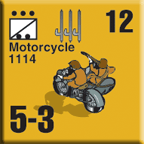Italy’s
Elite Infantry:
The Bersaglieri
By Mike Bennighof, Ph.D.
August 2014
In 1836, the Piedmontese Army adopted light infantry formations
similar to the French chasseurs and Austrian jägers.
These Bersaglieri, or ”sharpshooters,” wore distinctive
black uniforms with peaked hats, each hat trailing a long
feather. The brainchild of Alfonso della Marmora, these troops
would train to a very high physical standard, and also a high
standard of marksmanship.
La Marmora would later hold a series of high commands in
the Crimean War and in the 1866 war with
Austria. In his vision,
the Bersaglieri would act as companies of snipers, as light
infantry screening the slow-moving line formations, and as
special shock troops for key moments in battle.
La Marmora unveiled his creation during a military parade
on 1 July 1836, when his first company stormed through the
capital of Turin with the rapid (130 paces per minute), high-stepping
gait that still distinguishes the Italian Army’s Bersaglieri
battalions today. They made an instant impression on King
Carlo Alberto, and became an integral part of the Armata Sarda,
the Piedmontese professional army.
 When the Armata Sarda transformed into the Esercito Reale
Italiano (Royal Italian Army) in 1860, the number of Bersaglieri
regiments became fixed at 12. The Bersaglieri battalions at
first served as light infantry components of brigades and
divisions, but Army doctrine later in the century called for
them to be held back as corps-level reserves. When the Armata Sarda transformed into the Esercito Reale
Italiano (Royal Italian Army) in 1860, the number of Bersaglieri
regiments became fixed at 12. The Bersaglieri battalions at
first served as light infantry components of brigades and
divisions, but Army doctrine later in the century called for
them to be held back as corps-level reserves.
During the First World War, the 12 regiments of Bersaglieri
distinguished themselves, especially the four regiments grouped
together in the 47th Infantry Division. Of the 210,000 men
who served in Bersaglieri regiments, 32,000 were killed and
50,000 wounded.
After the war, Armando Diaz’s reforms reduced the number
of Bersaglieri battalions to two per regiment, and envisioned
a new role for the light infantry as part of Italy’s
commitment to mobile warfare. They would now serve as bicycle
troops alongside cavalry in the Celeri, or “fast,”
divisions. Gen. Ottavio Zoppi, one of Italy’s forward-thinking
theorists of the period between the wars, saw elite units
with aggressive spirit as one way to break the tactical stalemate
of the Great War. The Bersaglieri, he believed, gave Italy
the perfect formations for such a doctrine and an excellent
complement to tanks.
The connection between the Bersaglieri and modern warfare
continued when Italy formed armored divisions in early 1939.
Each division contained one Bersaglieri regiment, as did each
of the motorized divisions. All of the mobile divisions were
in northern Italy when Mussolini declared war in June 1940,
and no Bersaglieri fought in the initial campaigns in Egypt
and Libya.
Italy’s Bersaglieri regiments expanded to three battalions
each during the Second World War, but the Army resisted temptations
to water down their quality, and recruits had to be of above-average
size and stamina. They endured intense physical training,
just as their great-grandfathers had, and had to qualify as
marksmen.
Bersaglieri carried a carbine version of the Italian Army’s
standard 6.5mm 1891 model, a good marksman’s rifle but
lacking the power of other nations’ weapons. Other equipment
was standard except for the machine guns. Bersaglieri had
the 8mm Breda M1937, a modern weapon but hampered by being
clip- instead of belt-fed. The Breda left no “brass”
lying around, as the spent cartridges were re-inserted in
the clip as they were fired. Many line units still had the
Fiat M1914/35, a modernized Great War veteran.
Bersaglieri fought the French and the Greeks in 1940, but
the first Bersaglieri to see combat in North Africa, the 10th
Bersaglieri Regiment, crossed to Libya in early 1941 and headed
for the front. It met disaster before arriving there, when
British tanks ambushed its truck convoys well inside what
the regimental staff had been told was the secure rear area.



In all, six of the 12 regiments fought in North Africa, compiling
an excellent combat record. More than once, Bersaglieri units
fought to the last man to hold a position while German units
ran away.
In the two Panzer
Grenadier games set in the North African theater,
Afrika Korps and Desert
Rats, the Bersaglieri are easily the best Italian
units depicted, with firepower and range equivalent to German
units and usually superior morale. They also have trucks for
mobility, but are hampered somewhat through use of the same
inadequate 47mm anti-tank gun as other Italian formations.
At least they usually have more of them.
There are three flavors of Bersaglieri. One battalion of
each regiment rode into battle on motorcycles, much like truly
motorized cavalry, and these pieces appear often in the two
games’ 100+ scenarios. There are also Bersaglieri infantry
and machine gun units. The machine gunners have better firepower
than standard Italian pieces not only through their stricter
weapons training but also for carrying a better weapon than
the line units.
This piece originally appeared in March
2005. You can find an almost identical version (with no attribution to this piece) on another game company's website, but this is the original.
Click here to order Afrika Korps.
Click here to order Desert Rats.
Mike Bennighof is president of Avalanche Press and holds a doctorate in history from Emory University. A Fulbright Scholar and award-winning journalist, he has published over 100 books, games and articles on historical subjects.
He lives in Birmingham, Alabama with his wife, three children and his dog, Leopold. |
